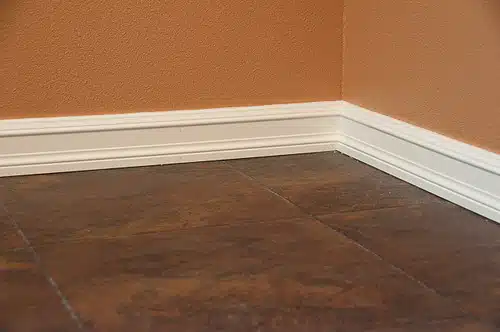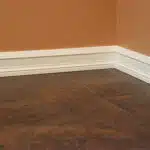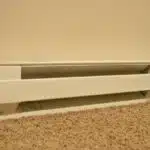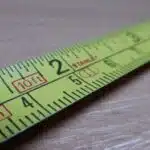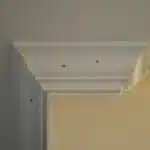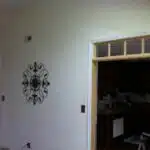The process of fitting baseboards with mitered inside corners is an essential carpentry skill that every woodworking enthusiast should possess. Mitered joints are used to create seamless and professional-looking corners, which can add a touch of elegance and sophistication to any room. The precision required in this technique is what sets it apart from other methods of jointing baseboards.
When fitting baseboards with mitered inside corners, the most important aspect is accurate measurement. Any slight deviation can lead to unsightly gaps or overlaps, which will ruin the overall appearance of the baseboard. This article aims to guide you through the step-by-step process of achieving perfect miter cuts and installing your baseboards seamlessly. With this knowledge, you will be able to create a polished finish for your home or a client’s project while also showcasing your skills as a carpenter or woodworking expert.
Understanding The Importance Of Mitered Inside Corners
Achieving a smooth and seamless look when installing baseboards requires precision and careful attention to detail. One of the most important aspects of fitting baseboards is creating mitered inside corners that meet at a perfect 90-degree angle. Inaccurate measurements or cuts can lead to unsightly gaps or overlaps, ruining the overall look of the installation.
To avoid common mistakes when fitting mitered inside corners, it is essential to understand the importance of precision. Even small variations in measurement or cutting angles can have a significant impact on the final result. It’s crucial to take the time to measure accurately and use precise cutting techniques to ensure a perfect fit.
Fitting mitered inside corners is not just about achieving an aesthetically pleasing finish; it’s also about ensuring functionality and durability. Precisely fitting corners will provide a secure joint that will stand up over time, preventing gaps from forming due to natural expansion and contraction of materials. With this in mind, taking extra care during this step of the installation process will make all the difference in achieving professional results. To get started on your project, let’s take a look at the tools you’ll need for the job.
Tools You’ll Need For The Job
A miter saw is essential for making accurate mitered inside corners, as it is designed to make quick, precise angled cuts. A tape measure, pencil and chalk line will be needed to measure and mark the lengths and angles of the cuts. A hammer, nail set and handsaw can then be used to properly fit and secure the baseboards into place. Finally, safety glasses, gloves, a utility knife, level, knee pads, sandpaper, caulk, and putty knife should also be available to complete the job.
Miter Saw
When it comes to installing baseboards with mitered inside corners, having the right tools is crucial. One of the essential tools for this job is a miter saw. A miter saw allows you to make precise cuts at different angles, making it an indispensable tool in carpentry and woodworking.
Before using a miter saw, it’s essential to prioritize safety. Always wear protective gear such as goggles and earplugs to avoid any accidents. Additionally, make sure that the blade guard is in place and that your hands are far from the blade when cutting.
Choosing the right blade for your miter saw is also critical. For cutting baseboards, it’s best to use a 10-inch or 12-inch fine-toothed blade with at least 80 teeth. A blade with more teeth will give you a smoother cut, ensuring that your baseboards fit tightly together without any gaps or rough edges. Remember to take your time and measure twice before making any cuts – precision is key when fitting baseboards with mitered inside corners!
Tape Measure
When it comes to carpentry and woodworking, measuring precision is crucial. This is where a tape measure becomes an essential tool for the job. A tape measure allows you to take accurate measurements of the baseboards, ensuring that they fit perfectly in their designated space. It is also important to note that common mistakes in measuring can result in uneven or improperly fitted baseboards.
To ensure proper measuring precision, start by aligning the end of the tape measure with one end of the baseboard and stretching it along its length. Avoid bending the tape measure as this can cause inaccurate measurements. It’s also best to double-check your measurements before making any cuts on the baseboard.
One common mistake when using a tape measure is taking inaccurate measurements due to incorrect alignment or misreading of measurement marks. Always make sure that your tape measure is aligned correctly and that you are reading the measurement marks accurately. Taking your time while measuring will save you from unnecessary waste of materials and rework later on.
Measuring Your Baseboards
Before you bust out your saw and cut your baseboards to size, there are a few things you need to consider. First and foremost, measuring techniques can make or break your project. It’s like the old adage says: measure twice, cut once. This means taking accurate measurements of your walls, corners, and floors to ensure that your baseboards fit snugly without gaps or overlaps. Remember, precision is key.
Common measurement mistakes include forgetting to account for angles and curves in your walls or measuring from the wrong spot altogether. To avoid these errors, use a combination of tools such as a tape measure, level, and angle finder. If you’re unsure about any of your measurements, double-check before making any cuts. A few extra minutes spent measuring now can save you hours of frustration later.
As a carpenter or woodworking expert, it’s important to understand that measuring is not just a technical task but an art form in its own right. Take pride in your work by ensuring that every measurement is accurate and precise. With these tips in mind, you’ll be well on your way to cutting your baseboards to size with confidence.
Transitioning into the subsequent section about ‘cutting your baseboards to size’:
Now that you’ve mastered the art of measuring techniques and avoided common measurement mistakes, it’s time to move on to the next step: cutting your baseboards to size.
Cutting Your Baseboards To Size
- Accurate measurement of the baseboard is essential for a clean, professional looking installation.
- Mark the mitered cuts with a carpenter’s pencil, ensuring that the angle is correct.
- Use a miter saw to cut the baseboard along the marks, taking care to ensure that the blade is set to the correct angle.
- Repeat the process for the second piece of baseboard, making sure all angles line up perfectly.
- Place the two pieces of baseboard together, checking to see that the mitered edges fit together snugly.
- Secure the baseboard in place with nails or screws and caulk the seams for a finished look.
Measurement
Accurate measurements are the foundation for perfectly fitting baseboards with mitered inside corners. To ensure precise cutting, start by measuring the length of each wall where you plan to install baseboards. Measure from corner to corner and record the longest measurement for each wall. Be sure to factor in any protrusions or angles that may alter the length of the baseboard required for a snug fit.
When measuring for inside corners, avoid common mistakes such as assuming that both walls are straight or using a single measurement for both sides of the corner. Instead, measure each side separately and subtract 1/8 inch from each measurement to allow room for adjustment during installation. If your walls are not square, adjust your measurements accordingly to account for any discrepancies.
Measuring tips aside, always remember to double-check your measurements before cutting your baseboards. It’s easier to make minor adjustments at this stage than it is to try and fix a poorly-fitting baseboard later on. By taking time to accurately measure and avoiding common mistakes, you’ll be well on your way to achieving professional-looking mitered inside corners that will enhance any room in which they’re installed.
Marking
After accurately measuring your walls for baseboards, the next step is to mark the baseboards according to your measurements. This process involves using a level and marking where you’ll make your cuts. When marking, it’s important to consider the height of the baseboard as well as any protrusions or angles on the wall that may affect its placement. By taking into account these factors, you can ensure that your cuts will be precise and fit snugly against the wall.
When marking for inside corners, be sure to use a pencil rather than a marker so that any errors can easily be erased. It’s also important to mark each piece of baseboard separately and label them accordingly so that they can be installed in their proper place without confusion. If you’re cutting multiple pieces at once, make sure they’re all stacked properly and secured together with clamps or tape to prevent any shifting during cutting.
Finally, before making any cuts, consider caulking as an additional step to ensure a professional finish. Once you’ve marked your baseboards and made your cuts, apply caulking along the edges where the baseboard meets the wall to fill in any gaps or imperfections. This will create a seamless appearance and enhance the overall look of your finished project. With careful marking and attention to detail, you can achieve perfectly fitting baseboards with mitered inside corners that will enhance the aesthetic appeal of any room in which they’re installed.
Cutting
Cutting your baseboards to size is a crucial step in achieving a seamless and professional finish for your walls. The first consideration when it comes to cutting is the type of saw you’ll be using. For straight cuts, a miter saw or chop saw is ideal, while coping requires the use of a coping saw or jigsaw. When selecting blades, ensure they’re sharp and appropriate for the material of your baseboards.
When making cuts, it’s essential to use proper technique and safety measures. Always wear eye and ear protection and keep your hands away from the blade. Take time to ensure accurate measurements and adjust your saw accordingly before making any cuts. For coping, use a coping saw or jigsaw to cut along the profile of the baseboard at a 45-degree angle, then sand down any rough edges.
Proper tool maintenance is also vital when cutting baseboards. Keep your saw blades clean and sharp to prevent damage to both the blade and material being cut. Lubricate moving parts regularly to ensure smooth operation, and store tools in a dry place away from moisture that can cause rusting. By following these guidelines for cutting and coping baseboards, you can achieve precise cuts that fit snugly against walls with mitered corners that enhance the overall look of any room without compromising safety or quality craftsmanship.
Preparing Your Miter Saw
To properly fit baseboards with mitered inside corners, you’ll need to prepare your miter saw. Before starting any cutting, it’s crucial to ensure that your saw is adjusted correctly. Adjusting angles is a critical step in making sure that your cuts are precise and accurate.
First, check the angle setting on your saw. The most commonly used angle for baseboard corners is 45 degrees; however, this may vary depending on the specific project requirements. Once you have determined the correct angle, adjust the saw accordingly. It’s important to carefully follow manufacturer instructions when making these adjustments to ensure safety measures are taken.
Secondly, take precautions when operating a miter saw by wearing protective gear such as gloves and goggles. Ensure that you have a stable work surface and that the saw blade is sharp and in good condition before beginning any cutting. Additionally, always keep your hands clear of the blade during operation.
Lastly, make sure that you’ve practiced enough before making actual cuts using your miter saw. Take time to familiarize yourself with its features and functions before tackling any actual cutting tasks. By taking these safety measures and adjusting angles correctly before beginning work on your baseboards, you can ensure that each cut will be precise and accurate.
Transition: Now that we have prepared our miter saw for use, let’s move onto making accurate miter cuts for our baseboard corners.
Making Accurate Miter Cuts
After preparing your miter saw, it’s time to tackle the task of fitting baseboards with mitered inside corners. This is a crucial step in achieving a professional-looking finish for your project. However, common mistakes can easily ruin your hard work, so it’s essential to follow best practices and consider alternative techniques when necessary.
When fitting baseboards with mitered inside corners, the most critical aspect is accuracy. Even small errors can result in unsightly gaps or overlaps that detract from the overall appearance. To ensure precision, use a quality miter saw and take careful measurements before making any cuts. Additionally, marking the baseboard where it meets the wall can help you visualize how the pieces will fit together.
Alternative techniques may also be useful when dealing with tricky angles or irregularities in your walls’ corners. One option is to use a coping saw to cut along the profile of one baseboard piece and fit it onto the other piece’s end grain. This creates a flush joint that eliminates gaps and overlaps. Another technique is to create a scarf joint by cutting both pieces at 45-degree angles and overlapping them slightly before securing them together.
In conclusion, fitting baseboards with mitered inside corners requires patience and attention to detail. By following best practices and considering alternative techniques as needed, you can achieve a flawless finish for your project. In the next section, we’ll discuss sanding and finishing your baseboards to complete the process.”
Sanding And Finishing Your Baseboards
As a carpenter or woodworking expert, you know that sanding your baseboards is an essential step in the finishing process. Before starting, ensure that all nails are countersunk and filled with wood filler. Sanding techniques vary depending on the type of wood used for your baseboards. If you are working with hardwood, use a coarse grit sandpaper to remove any rough spots and then switch to a finer grit for a smooth finish. For softwood, start with a medium grit sandpaper before moving to a fine grit for a polished look.
Once your baseboards are sanded, it’s time to choose your staining options. There are various types of stains available, including oil-based and water-based stains. Oil-based stains provide rich colors and deep penetration into the wood grain, while water-based stains dry faster and have less odor. When applying the stain, use long strokes in the direction of the wood grain to avoid streaks or blotches.
As you finish up sanding and staining your baseboards, keep in mind that proper ventilation is necessary to avoid inhaling dust particles or fumes from the stain. Wear protective gear such as gloves, goggles, and masks during this process. With these tips in mind, your baseboards will be ready for installation and can add an elegant touch to any room in your home.
Installing Your Baseboards
With your baseboards sanded and finished, it’s time to start installing them. Begin by measuring the length of each wall you will be installing baseboards on and cutting the boards accordingly. When it comes to fitting baseboards with mitered inside corners, precision is key. Mitered corners have a 45-degree angle cut at each end that creates a seamless joint when two pieces meet at a corner.
To fit mitered inside corners, start by making two 45-degree cuts on one end of a board. Then, measure the distance from the corner to where the other end of the board will meet another piece of baseboard. Make another 45-degree cut on that end of the board but in the opposite direction. Repeat this process for the other piece of baseboard that will connect at the corner. You should now have two pieces with opposing 45-degree cuts that fit together perfectly at a 90-degree angle.
Painting techniques can add an extra touch of elegance to your newly installed baseboards. Before painting, consider material options such as wood or MDF (medium-density fiberboard). Wood is more expensive but has a higher-quality look and feel while MDF is easier to work with and less expensive. Both materials can be painted using traditional methods such as brushing or spraying, but for a smoother finish, consider using a paint sprayer. With careful installation and attention to detail during painting, your new baseboards will give any room in your home an added touch of sophistication.
Transition: Now that you know how to make mitered inside corners and have chosen your material options, it’s time to move onto creating the perfect inside corner joint for seamless results.
Creating The Perfect Inside Corner Joint
To create the perfect inside corner joint when fitting baseboards, there are a few common mistakes that should be avoided. One of the most prevalent errors is cutting the miter at an angle that is not precisely 45 degrees. This can lead to unsightly gaps or overlaps in the joint. Another mistake is failing to ensure that the two pieces of baseboard are flush with each other before securing them together.
To avoid these issues and achieve a flawless inside corner joint, expert tips include using a high-quality miter saw and taking time to measure and mark precisely before making any cuts. It’s also essential to make sure both pieces of baseboard fit snugly against each other before securing them with glue and nails.
Alternative jointing methods, such as coping, may also be used for particularly tricky angles. Coping involves cutting out the profile of one piece of baseboard so it fits perfectly over the other piece, creating a seamless joint without any visible gaps or overlaps. However, this method requires more time and skill than simply cutting a mitered joint, so it may not be suitable for everyone. Understanding the pros and cons of different jointing methods can help you choose the best approach for your specific project needs.
Transition: While mitered joints are ideal for most inside corners, sometimes tricky angles require alternative techniques such as coping. To master this technique, you’ll need to know how to use a coping saw effectively – which we’ll cover in our next section.
Using A Coping Saw For Tricky Angles
After creating the perfect inside corner joint, the next step is fitting baseboards with mitered inside corners. This task requires precision and patience to ensure that the resulting angles are seamless and aesthetically pleasing. Before starting, it is important to gather all the necessary tools and materials such as a measuring tape, saw, nails, hammer, wood glue, and a coping saw.
Coping saw techniques can be useful in achieving tricky angles when fitting baseboards with mitered inside corners. When cutting the baseboard at a 45-degree angle, use a coping saw to carefully remove any excess wood from the back of the board. This will allow you to fit your baseboard perfectly into any irregularities in your wall or floor. It is also important to use wood glue on both ends of your mitered corner before nailing it in place for added stability.
Troubleshooting tips include identifying gaps between the baseboard and wall after installation. If this happens, fill in these gaps using wood filler before sanding it down for a smooth finish. Also, ensure that your measurements are precise before making any cuts to avoid having to redo any work. By following these tips and techniques, you can achieve professional-looking results when fitting your baseboards with mitered inside corners.
When installing baseboards with mitered inside corners, one of the most challenging aspects can be aligning them correctly. To do so effectively, start by laying out your baseboards along each wall before making any cuts or attaching them with nails. Use a level tool to ensure that they are straight before marking where each cut should be made. By taking these steps and patiently working through each corner joint, you can successfully align your baseboards for an attractive finished look without any visible seams or gaps.
Tips For Aligning Your Baseboards
Accurate measurements are essential when installing baseboards. It is important to measure the wall from corner to corner and mark the desired finished length on the baseboard. Baseboards should be cut to size and mitered so they can fit together perfectly. Take special care when cutting the mitered angles to ensure they fit together without gaps. Once the baseboards are ready, they should be installed with a nail gun, making sure the nails are driven close together for a secure fit. Finally, caulk should be applied to fill in any gaps and ensure the baseboard is sealed against the wall.
Measuring The Wall
Measuring techniques are crucial when fitting baseboards with mitered inside corners. To ensure a perfect fit, it is essential to measure the wall accurately. Start by measuring the length of the wall where you plan to install your baseboard. Use a tape measure for this and record the measurement on paper. Next, measure the height of the wall from floor to ceiling and record that measurement too.
Wall irregularities can make installing baseboards challenging. Before starting, you should examine the wall for any bumps or dips that could affect how well your baseboard fits. If there are any irregularities, use a level to identify them and record their location on paper. You can then adjust your measurements accordingly to ensure a snug fit.
In conclusion, measuring is crucial when fitting baseboards with mitered inside corners. Measuring techniques and identifying wall irregularities will help you achieve an excellent finish in your carpentry project. With these tips in mind, you can be confident in achieving professional results every time you tackle this woodworking task.
Preparing The Baseboard
When it comes to woodworking, there are essential steps that you should never skip. One of those critical steps is preparing the baseboard before installation. Choosing materials that are durable and suitable for your project is crucial. You want your baseboards to look good and last long, so take the time to select the best quality materials you can afford.
After choosing your materials, the next step is sanding. Sanding helps smooth out any rough edges or imperfections on the surface of your baseboard. This process will help prepare your baseboard for painting or staining, which will give it a polished look once installed. Remember to use fine-grit sandpaper and work in the direction of the wood grain to avoid damaging the surface.
In conclusion, preparing your baseboards is an essential step in achieving professional results when installing them with mitered inside corners. Choosing high-quality materials and sanding them thoroughly will ensure that they fit snuggly against the wall and look great for years to come. Keep these tips in mind as you tackle this woodworking task, and you’ll be on your way to creating beautiful carpentry projects that will impress everyone who sees them.
Installing The Baseboard
When it comes to installing baseboards, there are several essential steps that you should follow to achieve professional results. Choosing suitable materials and sanding your baseboard thoroughly is crucial for a polished look. However, aligning your baseboards correctly is equally important. If you want your baseboards to sit flush against the wall and create a seamless finish, then you’ll need to pay close attention to these tips.
Before installing your baseboard, start by measuring the length of each wall where you will be installing them. Cut the baseboard at a 45-degree angle using a miter saw or box cutter, making sure that they fit snugly together with no gaps or overlaps. It’s always better to measure twice and cut once to avoid any mistakes that could result in wasted material.
To ensure that your baseboards are levelled correctly, use a level tool and check as you go along. Nail or glue your baseboards onto the wall starting from one corner of the room and working your way around in one direction. Decorating your baseboards with paint or stain after installation will give them a final touch and enhance their appearance while protecting them from wear and tear.
By following these tips for aligning your baseboards, you can achieve professional-looking results that will elevate the look of any room. Remember always to take accurate measurements, use proper tools like level tools when needed, and choose high-quality materials for long-lasting durability and beauty.
Dealing With Imperfections And Mistakes
Dealing with imperfections and troubleshooting mistakes is an essential part of the baseboard installation process. Even the most experienced carpenters make mistakes, and it’s important to know how to fix them properly without compromising the overall look of your finished product. When installing baseboards, you may encounter issues such as gaps between the baseboard and the wall or uneven miters. These problems can be fixed with a few simple techniques.
To deal with imperfections, start by filling in any gaps between the baseboard and the wall with a paintable caulk or wood filler. Once dry, sand down any excess material until smooth. If you notice that your mitered corners are not lining up correctly, try using a coping saw to trim away any excess wood until they fit snugly together. It’s important to take your time during this process to ensure that your baseboards look seamless and professional.
Troubleshooting mistakes is another critical aspect of baseboard installation. If you accidentally cut a piece too short or damage a section while installing it, don’t panic! You can easily replace damaged pieces by cutting new ones to size and attaching them in place of the old ones. If you’re having trouble getting certain sections to fit correctly, try using a block plane or rasp to shave off small amounts of wood until they fit snugly into place.
- Use wood glue when attaching baseboards for added security.
- Always measure twice before making any cuts.
- Sand edges smooth before painting or staining.
- Remember that patience is key when dealing with imperfections or troubleshooting mistakes.
Moving forward with your project, maintaining your baseboards will be crucial in keeping them looking their best for years to come.
Maintaining Your Baseboards
Dealing with imperfections and mistakes is a crucial aspect of baseboard installation. However, maintaining your baseboards afterwards is equally important to ensure their longevity. Over time, baseboards may develop cracks or chips due to wear and tear or accidental damage.
To maintain your baseboards, it is important to clean them regularly. Dust and dirt can accumulate on the surface and in crevices, which can be detrimental to the finish. Use a soft cloth or brush to remove dust and debris, and avoid using abrasive cleaning agents.
If you notice any damage to your baseboards, it is important to repair them as soon as possible. Small cracks or chips can be filled with wood putty or filler. For larger damages, it may be necessary to replace the affected section of the baseboard entirely. Keeping your baseboards well-maintained will not only enhance their appearance but also contribute towards maintaining a healthy living environment in your home.
As you gain more experience installing baseboards, you may want to explore other jointing techniques beyond mitered inside corners. These include coped joints where one end of the baseboard is shaped to fit snugly over the profile of the adjacent board’s end grain, thereby achieving a seamless joint even if walls are not square. Additionally, butt joints where two sections meet at a 90-degree angle can be reinforced by adding glue blocks behind each board for extra stability. Experimenting with different techniques will ultimately lead you towards finding what works best for your specific project needs.
Exploring Other Jointing Techniques
When it comes to fitting baseboards with mitered inside corners, there are a few joinery alternatives that you might want to consider. While miter joints are an attractive option for clean and seamless corner connections, they can be tricky to execute perfectly. Fortunately, there are other techniques that can help you achieve the desired look without compromising structural integrity.
One alternative is the cope joint. This method involves cutting a profile into one end of the baseboard so that it matches the contour of the adjacent board’s profile. The result is a snug fit that requires less precise cutting than a miter joint. Another decorative corner option is a plinth block or rosette, which acts as an intermediary between the baseboard and casing to create an elegant transition between them.
In addition to these joinery alternatives and decorative corner options, showcasing your professionalism as a carpenter can go a long way in impressing clients and colleagues alike. Taking extra care in measuring, cutting, sanding, and finishing your work can demonstrate your attention to detail and dedication to quality craftsmanship. By taking pride in your work and striving for excellence in every project, you can establish yourself as a skilled and reliable carpenter who is committed to serving others through your craft.
Showcasing Your Professionalism As A Carpenter
Exploring Other Jointing Techniques was an interesting section, but now let’s focus on the task at hand. Did you know that according to a recent study, installing baseboards can increase the value of your home by up to 6%? That’s why it’s essential to learn how to fit baseboards with mitered inside corners correctly.
To start, you need to measure the length of each wall and cut the baseboard accordingly. Next, mark a 45-degree angle on one end of the first board and another on the opposite end of the second board that will meet in the corner. Once you have cut both boards at their respective angles, you can dry-fit them together without any nails or adhesive. This step is crucial because it allows you to check if there are any gaps or unevenness before attaching them permanently.
Tips for fitting mitered inside corners include making sure that both boards are tight against each other and using a clamp to hold them in place while nailing them together. Additionally, using wood glue on the joint before nailing will enhance its strength and durability. Techniques such as coping may also be useful for creating seamless joints between complex angles.
| Pros | Cons |
|---|---|
| Adds value to your home | Requires precise measurements |
| Provides a finished look | Can be time-consuming |
| Allows for flexibility in design | Requires some woodworking knowledge |
In conclusion, fitting baseboards with mitered inside corners is an essential skill for any carpenter or DIY enthusiast. By following these tips and techniques, you can create professional-looking joints that add value and beauty to your home. Remember always to measure twice and cut once!
Conclusion
In conclusion, fitting baseboards with mitered inside corners is a skill that every carpenter should master. It requires precision, patience, and attention to detail. By understanding the importance of mitered inside corners and using the right tools for the job, you can achieve a flawless finish that will enhance the beauty of any room.
Remember, measuring your baseboards accurately is crucial, as even the slightest mistake can ruin your design. Preparing your miter saw properly and dealing with imperfections and mistakes are also important steps in achieving success. Finally, exploring other jointing techniques such as coped joints or scarf joints can add variety to your work and showcase your professionalism as a carpenter.
As you master this skill, you will be able to create beautiful homes that reflect the unique taste of each client. Your work will speak for itself as it stands out from ordinary carpentry. Keep honing your craft and always strive for excellence in everything you do. The satisfaction of creating something beautiful with your own two hands is priceless.
Image Credits
- “Laundry room remodel baseboard detail” by Sitka Projects LLC (featured)

